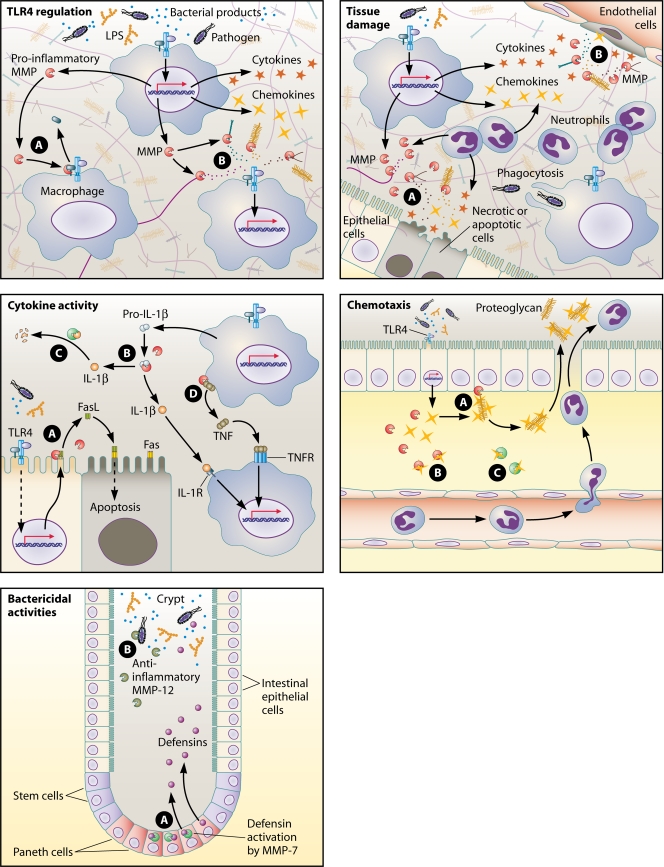FIG. 3.
MMPs influence the response to LPS or gram-negative bacteria via different mechanisms. (Top left) TLR4 regulation. TLR4 triggering by bacterial products leads to the activation of macrophages, which respond to the LPS by producing many proinflammatory mediators, such as cytokines, chemokines, and MMPs. MMPs can cleave membrane-bound CD14 into its soluble form, which can be used by cells lacking this coreceptor (A). Cleavage of the ECM generates alternative TLR4 triggers (B) and possibly relieves the receptor from the suppressive mechanism that is exerted by the ECM. (Top right) Tissue damage. Macrophages and neutrophils are attracted to the site of infection and eliminate the pathogen by releasing a massive amount of toxic products, such as reactive oxygen species, cytokines, and MMPs. Finally, pathogens are phagocytosed and tissue repair is initialized. The toxic products efficiently kill bacteria, but they can also be very harmful to the host if they are released in large amounts, as is the case in sepsis. Consequently, aberrant cleavage of the ECM by the overzealous production of MMPs leads to epithelial (A) and endothelial (B) damage. (Middle left) Cytokine activity. FasL is expressed at the cell membrane of epithelial cells in response to LPS. By shedding, MMP-7 releases the soluble form of FasL (A), which induces apoptosis after binding its receptor Fas. Activated macrophages produce many cytokines. The mature IL-1β, as well as its pro form, is secreted. MMPs can activate the pro form of this cytokine (B) but can also degrade the mature form (C). The major TNF sheddase is TACE, but MMPs also can solubilize this cytokine (D). (Middle right) Chemotaxis. Activated epithelial cells secrete MMPs and chemokines. Chemokines can be sequestered by proteoglycans of the ECM; by cleaving these proteoglycans, MMPs generate a chemokine gradient (A). Chemokines too can be directly activated (B) or inactivated (C) by MMPs. (Bottom left) Bactericidal activities. Paneth cells, which lie at the base of the crypts between the villi of the small intestine, produce antibacterial products, such as lysozyme and defensins. In the mouse, MMP-7 activates these defensins and thus plays an anti-inflammatory role (A). MMP-12, on the other hand, contains a cathelicidin-like domain with direct bactericidal activities (B).

